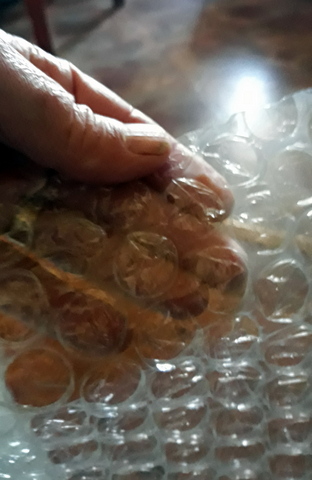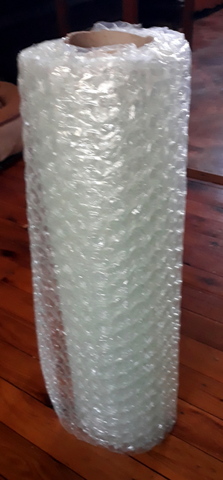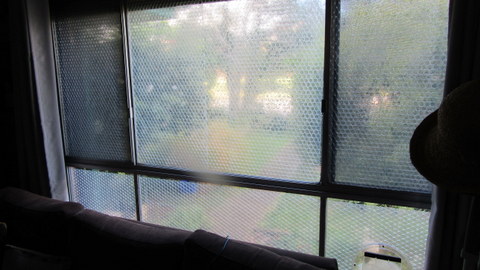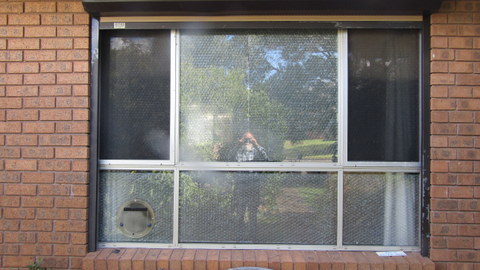What do these two things have in common? You may well ask, and the fact is that bubblewrap can be used as a cheap, easily applied and removed, fairly effective substitute for double glazing your windows. Interested? Read on!

WE have a ‘70s house, and large aluminium windows were the ‘in’ thing when it was built. That is great for light, but not so great for heat – the windows let heat in when we want to stay cool, and let heat out when we are trying to stay warm. We have developed ways around it: we have wind up shutters on the front of the house and use fitted in sheets of polystyrene for the windows along the back (we have no windows on either side wall of the house). This can work very well in summer, when a dark and cool house interior is desirable, but in winter we want to let the light in while keeping the heat in too, and both of these strategies (shutters and poly sheets) reduce the light coming in considerably, if not entirely.

I have had this thought in my mind that we should give bubblewrap a go as a window insulator since I read about it quite a few years back. Unfortunately, Linda was not quite as enthused as I was and thought that it would look tacky at best, or look like crap at worst. I eventually wore her down and got her to agree to trial some on the glass panel beside the front door. She would be able to get a feeling for how it looked without it being too obvious from outside.
I had gotten hold of a 25m roll of 500mm wide bubblewrap with 20mm bubbles when I first got the idea, and kept it hanging around until I got approval to use it. So, the thing was, I applied it to the window near the door and she loved it!
To apply it was deceptively simple, I just –
1. wiped the inside of the window over with a damp cloth to remove and dirt, dust etc.
2. used a pump action sprayer full of water to spray the inside of the window with a fine spray such that the window was wet all over.
3. Placed the bubblerwrap against the window, bubble side against the glass, then smoothed it down with my hands so that all bubbles were in contact with the wet glass.
4. That was it!
It was a remarkably easy process with the bubblewrap adhering to the wet glass almost immediately it was applied, but still being able to be moved around so it fits the window properly. It only took a couple of minutes to smooth it out to the point where it was completely attached to the window and was ready to go.
We now have it on the lounge room window (largest in the house), dining room, kitchen, and Linda’s work room, and did have it on the bathroom window. All of this has taught us a number of things about using bubblewrap as double glazing.
1. Cutting out – I tried a sharp knife cutting s number of layers but a sharp pair of scissors works best. When cutting across the sheet (at least for the sheet I used) pick a spot between the lines of bubbles, this is the easiest to cut as well as making it easy to keep cutting a straight line. Cutting along the sheet is also easy to follow a straight line but one line of bubbles will get cut because there is no clear line between them in this direction. It is also better to cut a little short rather than a little over the measurement if you can’t get it exact, because if it is a little over it can cause the edge to lift and start the bubblewrap coming off, over time.
2. The clarity of the bubblewrap improves over time while it is in place – when you spray the water on the glass, then apply the bubblewrap, it reduces the clarity of the glass somewhat and makes it more difficult to see through. It turns out that this effect is only temporary and over a week or two the water layer seems to evaporate (or something) and you are left with a much clearer window.
3. It won’t work on stippled windows – you know, the privacy window glass used in toilets, bathrooms and sometimes other rooms as well. The interior of the window glass is made translucent but not transparent by a whole stack of tiny protrusions designed to stop you seeing through the privacy glass. These protrusions allow the bubblewrap to adhere to the glass only while the glass remains wet. As the glass dries (see 2 above) the bubblewrap slowly starts to come away from the glass under the action of gravity and eventually it falls off entirely. So you can use this method on toilet/bathroom windows but will have to wet down and re-apply every 2 to 3 weeks, if you are okay with that, go for it!
4. It allows more light in (sort of!) – This one is a little more difficult. As with most houses, the front of our house faces the street. We have large windows facing the street and use a combination of block out curtains (which we draw at night) and continuous lace curtains which we use to maintain our privacy during the day. These lace curtains do reduce the light coming into the front rooms, particularly the lounge room and particularly during winter. What we found, however, was that the bubblewrap provided sufficient obscurement from the street for our privacy such that we could dispense with the lace curtains. On balance the bubblewrap lets much more light into the lounge room making it an easier and more pleasant place to be on a winter’s day.
5. Does it work? – This one is also a little more difficult. I have read of a phenomenon called cold radiation, which allows something like cold glass to suck heat out of a room to the point where you can feel it cooling you when you walk past a cold sheet of glass. If I touch one of our windows on a cold night, it feels cold (yeah, I know, DER!) but if I touch the back of the bubblewrap applied to that same cold window, it feels a bit cool and that is it. You also don’t get the cold feeling waking past a window with the bubblewrap on it. The window does not cool the air in the room by convection either (warm air hitting the window, having the heat sucked out and then falling to the floor then being replaced by more warm air, you get a cycle which cools the air in the room). There is some residual cooling by the aluminium window frame which is not covered and is still transmitting cold into the room but the vast majority of the area where the heat is lost has been covered.
The end result of this is that the room seems to warm up quicker when we put the fire on and stay warmer longer, increasing our level of thermal comfort. Sorry, I don’t have access to technology like a thermal imaging camera so I can’t give you any numbers, but it does feel warmer for longer.
So, in summary, bubblewrap is a cheap and readily available, easily applied and removed substitute for double glazing which reduces the heat lost through the windows to which it is applied, thus improving comfort and saving money on heating.





